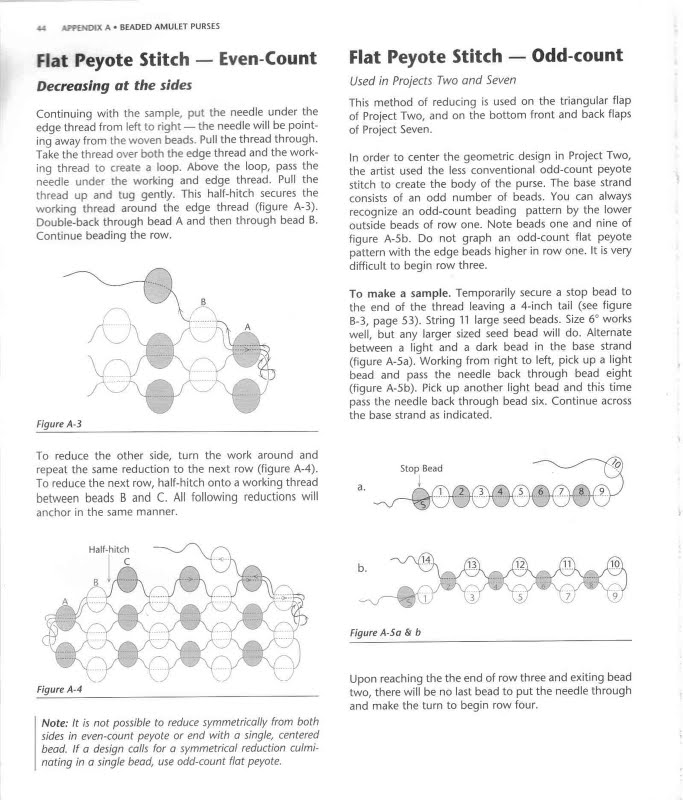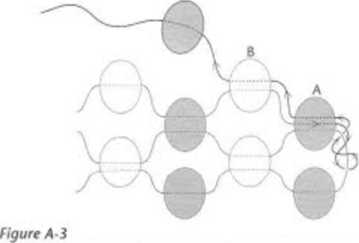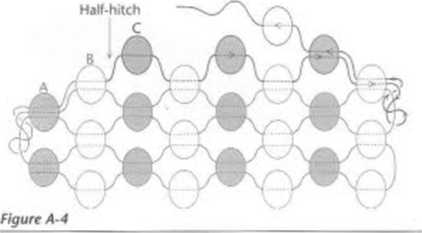44

*4 AFPtNDtt A • BEADED AMULET PURSES
Fiat Peyote Stltch — Even-Count
Decreasing at the sides
Continuing with the sample, put the needle under the edge thread from left to right — the needle will be point-ing away from the woven beads. Puli the thread through. Take the thread over both the edge thread and the work-ing thread to create a loop. Above the loop, pass the needle under the working and edge thread. Puli the thread up and tug gently. This half-hitch secures the working thread around the edge thread (figurę A-3). Double-back through bead A and then through bead B. Continue beading the row.

Fiat Peyote Stitch — Odd-count
Used in Projects Two and Seven
This method of reducing is used on the triangular flap of Project Two, and on the bottom front and back flaps of Project Seven.
In order to center the geometrie design in Project Two, the artist used the less conventional odd-count peyote stitch to create the body of the purse. The base strand consists of an odd number of beads. You can always recognize an odd-count beading pattern by the lower outside beads of row one. Notę beads one and nine of figurę A-5b. Do not graph an odd-count fiat peyote pattern with the edge beads higher in row one. It is very difficult to begin row three.
To make a sample. Temporarily secure a stop bead to the end of the thread leaving a 4-inch taił (see figurę B-3, page 53). String 11 large seed beads. Size 6° works well, but any larger sized seed bead will do. Alternate between a light and a dark bead in the base strand (figurę A-5a). Working from right to left, pick up a light bead and pass the needle back through bead eight (figurę A-5b). Pick up another light bead and this time pass the needle back through bead six. Continue across the base strand as indicated.

To reduce the other side, turn the work around and repeat the same reduction to the next row (figurę A-4). To reduce the next row, half-hitch onto a working thread between beads B and C. Ali following reductions will anchor in the same manner.

Notę: tt is not possible to reduce symmetrically from both sides in even-count peyote or end with a single, centered bead. If a design calls for a symmetrical reduction culmi-nating in a single bead, use odd-count fiat peyote.

Upon reaching the the end of row three and exiting bead two, there will be no last bead to put the needle through and make the tum to begin row four.
Wyszukiwarka
Podobne podstrony:
*4 AFPtNDtt A • BEADED AMULET PURSESFiat Peyote Stltch — Even-Count Decreasing at the sides Continui
APPEMMK A • BEADED AMULET PURSESTubular Peyote Stitch —Even Count Used in Projects One, Four and
BEADED AMULET PURSES • APPENDIX A 43Appendix ABeading Technigues Figurę A-la&b. The thread gaps
BEADED AMULET PURSES • APPENDIX B 57How to read even-count tubular peyote graphs The tubular peyote
BEADED AMULET PURSES • PROJECT ONE 11 To make the strap. Think oł the strap as a necklace. Choose th
16 PROfECT THREE • BEADED AMULET PURSES 16 PROfECT THREE • BEADED AMULET PURSESProject ThreeRain For
BEADED AMULET PURSES • PROIECT THREE 17 Sections to be read before beginning: • Tu
IS rRO)£CT THREE • BEADED AMULET PURSES To apply edge bcading to the ribbon. After the ribbon is sti
BEADED AMULET PURSES • PROJECT SIX 31 Sections to read before beginning: •
BEADED AMULET PURSES • PROJECT SIX 33 To add the fringes to the edges. Add two-bead fringes between
BEADED AMULET PURSES • PROIECT SEVEN i ) Figurę 4 To make the triangular points at the top of the pu
BEADED AMULET PURSES • PROJECT SEVENHHŁ jLJLJMBBULlUBaBCBBDCUBUBUBaJ
więcej podobnych podstron